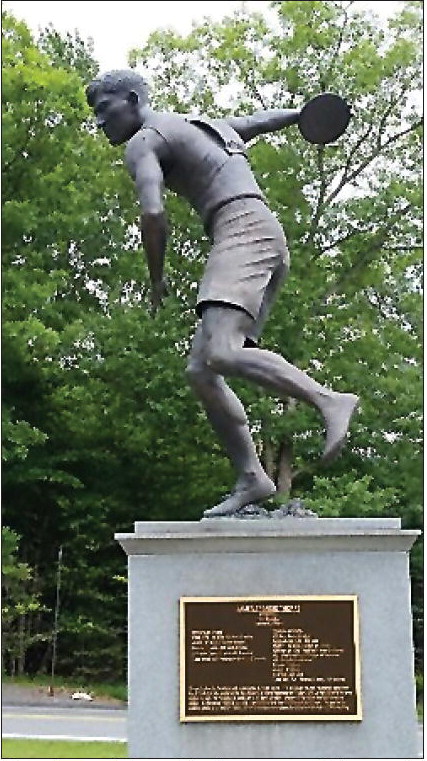continued from page gered on ….


continued from page
gered on until August 1918, when the Army took it back for war uses, the retraction of Thorpe’s medals was the fatal blow to its existence. Thorpe himself remained loyal to Carlisle, visiting the campus when his work brought him nearby, and even inviting Superintendent Friedman to participate in his wedding. He repressed the hurt of losing the medals and revealed it only in private moments.
In order to support himself, Thorpe left Carlisle and played professional football and baseball. As a major box office draw, he helped put professional football on its feet, serving as first president of the forerunner of the National Football League. He is a main reason pro sports are now so deeply a part of American life.
Later he became a professional coach and motivational speaker for young people. Thorpe struggled to stay employed after leaving professional sports. He moved from state to state, working as a painter, security guard, and ditch digger. He even tried out for some movie roles but was given only a few cameos, mainly playing Indian chiefs.
When the 1932 Olympics came to Los Angeles, Thorpe was living in the city, but he didn’t have enough money to buy a ticket. Vice President Charles Curtis, also of Native American descent, invited Thorpe to join him. When the crowd became aware of Thorpe's presence, he was honored with a standing ovation. In 1951, Thorpe was memorialized in the Warner Bros. movie about his life Jim Thorpe – All-American, which is now on DVD.
Thorpe married three times and had a total of eight children. In 1913, he married Iva M. Miller, whom he had met at Carlisle. They had four children: James F., Gale, Charlotte, and Frances Thorpe. They divorced in 1925. In 1926, Thorpe married Freeda Verona Kirkpatrick, who was working for the manager of the baseball team for which he was playing at the time. They had four sons: Phillip, William, Richard, and John Thorpe. They divorced in 1941, after they had been married for 15 years. Last, in 1945 Thorpe married Patricia Gladys Askew, who was with him when he died.
Over the years Thorpe’s family and friends kept petitioning the International Olympics Committee (IOC) to restore his rightful honors. The campaign intensified after Thorpe suffered a fatal heart attack on March 28, 1953, and died at the age of 64 in Lomita, California. Avery Brundage, who was the president of the IOC from 1952 to 1972 pushed against the campaign to get the medals back to Thorpe. Brundage had an ulterior motive as he had competed against and lost out to Thorpe in the 1912 Olympics in the pentathlon and decathlon.
Brundage has been blamed for everything from stealing Thorpe’s track shoes at Stockholm to reporting his lack of amateur status to the IOC. With Thorpe removed from the winner status, Brundage became the national all-around champion, a standing that helped open doors to his construction business. Brundage retired in 1972, and the next year the AAU voted to reinstate Thorpe’s amateur status.
But the tipping point came when a copy of the rules for the 1912 Olympics was located and shown to state that objections to the qualification of a competitor “must be . . . received by the Swedish Olympic Committee before the lapse of 30 days from the distribution of prizes.” The letter from the AAU in 1913 disqualifying Thorpe had arrived well past the deadline. The retraction of Thorpe’s medals not only was unfair, it was illegal. With this evidence, on October 13, 1982, the IOC voted to restore Thorpe’s honors. However, the original medals had both been stolen from Scandinavian sports museums. So the IOC proposed striking commemorative medallions, rather than Olympic medals. Thorpe’s supporters objected to medallions, and through friends in Sweden located the molds for the original medals. New medals were struck from the original molds, not of gold as Thorpe’s had been since gold had been discontinued for the medals after 1912, but of the modern silver alloy with gold plating. The new medals were presented to Thorpe’s children in Los Angeles in 1983, as part of the build-up to the 1984 Los Angeles Olympics.
Thorpe’s daughters Gail and Grace presented the medals to the Oklahoma Historical Society, which put them on display in the State Capitol. However, a security guard stole the medals, and after they were recovered, the state decided they would be safer in the Oklahoma Historical Society. Through special arrangement with the Historical Society, Thorpe’s surviving sons William and Richard put the medals on display at the National Museum of the American Indian and at the London Olympics. Again, in spite of Jim Thorpe’s effortless grace as an athlete, nothing about his memory has been easy. There was another conflict about the resting place of his body. After his death in Oklahoma in 1953, his last wife Patricia removed his coffin and offered the towns of Mauch Chunk and East Mauch Chunk in eastern Pennsylvania the honor of maintaining his final resting place as a tourist attraction. The towns renamed themselves Jim Thorpe, PA, and now maintain a shrine and museum for him.
Thorpe’s children have lobbied for years for the return of his body to Sac and Fox territory. His surviving sons finally brought a lawsuit under the Native American Graves Protection and Repatriation Act. After the United States Supreme Court recently refused to hear an appeal by the Thorpe family, the case was over. Jim Thorpe, to this day, remains in the town named for him, Jim Thorpe, Pennsylvania.
In 1950, Thorpe was voted by Associated Press sportswriters as the greatest football player of the half-century. Just months later, he was honored as the best male athlete of the half-century. Three decades after Thorpe's death, the International Olympic Committee reversed its decision and issued duplicate medals to Jim Thorpe's children in 1983. Thorpe's achievements have been re-entered into Olympic record books, and he is now widely acknowledged as one of the greatest athletes of all time.






